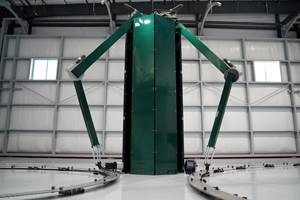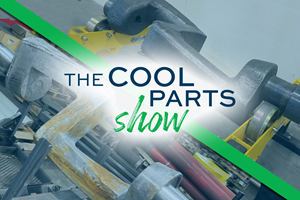Consortium Aims to Bring High-Value 3D Printing to UK
Additive manufacturing experts aim to create accessible, large-format additive manufacturing technology that will make UK manufacturing more competitive and sustainable.
Additive manufacturing (AM) experts in the United Kingdom are working on the EVO One large-format additive manufacturing (LFAM) project to create a 3D printer system that could make UK manufacturers more competitive in the international market. The initiative has received £1.1 million in funding from Innovate UK, the UK’s innovation agency.
Collaborators on the EVO One LFAM project include EVO 3D; the National Manufacturing Institute Scotland (NMIS) operated by the University of Strathclyde and part of the High Value Manufacturing Catapult (HVMC); Rolls-Royce; materials supplier Filamentive; software developer AI Build; and energy technology company Baker Hughes.
The advanced technology being developed by this global consortium of companies and academic institutions could revolutionize the use of industrial AM in the UK, bringing the advanced manufacturing of high-value components for key industries to the country for the first time.
LFAM is a commercial 3D printing technique that creates large-volume polymer components, used in a variety of industries, including aerospace, automotive, energy and marine. While countries like the U.S., Germany and China have embraced this approach, the group says there are currently no manufacturers of large-format 3D printers in the UK. Also, the UK only accounts for around 5% of the global AM market, which the UK government aims to increase to 8% by 2025.
Access to the right technologies will be a crucial part of achieving that aim, but existing LFAM systems have their limitations. These include slow build times, being unsuitable for high-value or high-integrity parts, operational complexity, use of unsustainable materials, and being unaffordable for small- and medium-sized companies.
The new product being developed through Evo One LFAM will address the challenges associated with these systems and cater to the specific needs of the UK Market. The system’s design team is aiming to make it 60% more reliable, achieve a 50% increase in productivity, reduce training and maintenance costs by 30%, and cut material waste by 80%, among a range of other improvements.
On the project’s completion, Evo-3D will launch a spinout business to commercialize the system, called RapidFusion, creating the UK’s first original equipment manufacturer (OEM) in LFAM. Its development would also create the foundation on which a new supply chain can be built, reshore critical manufacturing capabilities, and help more UK manufacturers take advantage of the opportunities presented by Industry 4.0.
“The UK is behind other major economies when it comes to LFAM. What we are aiming to do through the development of this system is democratise high-value, environmentally responsible manufacturing in the UK through a system that will bring the latest technology and capabilities to large and small businesses,” says Jake Hand, director of marketing and development at EVO 3D. ““We saw during the pandemic how easily supply chains can crumble. That’s why it’s potentially more important than it ever has been to develop as much capacity and capability in the UK as we can, not to mention the economic and carbon reduction opportunities associated with having a thriving manufacturing sector at the vanguard of the latest available green technologies.”
The NMIS team will support the project across a number areas, including material analysis, design and the AM process. It will also look at the validation and verification of the system and high-value materials being used. Rolls-Royce and Baker Hughes will test the system once it is ready, while AI Build will help with the development of the slicing technology.
“We have a huge opportunity in the UK to be a leader in large format additive manufacturing. Putting the right technology in as many manufacturers’ hands as we can is a great base to build on, and having a UK-based OEM is the first step in that direction,” says Stephen Fitzpatrick, director – digital factory at NMIS. “With the right tools at our disposal, we can encourage more manufacturers of all sizes to embrace the latest manufacturing techniques and technologies, paving the way for a more sustainable and globally competitive sector.”
Related Content
Next-Gen Horse Trailers to Be Built With Robotic 3D Printing
Double D Trailers is currently developing a prototype horse trailer that will be made with large-format additive manufacturing. The technology brings potential benefits for labor, weight and design features to this subset of recreational vehicles.
Read More3D Printing Brings Sustainability, Accessibility to Glass Manufacturing
Australian startup Maple Glass Printing has developed a process for extruding glass into artwork, lab implements and architectural elements. Along the way, the company has also found more efficient ways of recycling this material.
Read More“Mantis” AM System for Spacecraft Uses Induction for Deposition
The metal 3D printing system melts wire without lasers. 30-foot-diameter parts are built on a rotary-feed system that eliminates the need for a large machine frame or gantry.
Read MoreRobot Deposition Makes Giant Industrial Mixer Blade: The Cool Parts Show Bonus
Wire arc additive manufacturing produces a large component formerly made through casting, and allows for redesign of its internal cooling geometry.
Read MoreRead Next
To Improve Performance of Compression Molded Composites, Add 3D Printed Preforms
9T Labs' Additive Fusion Technology enables the manufacture of composite structures with as much or as little reinforcement as is necessary, using 3D printed continuous fiber preforms to add strength just where needed.
Read MoreLooking to Secure the Supply Chain for Castings? Don't Overlook 3D Printed Sand Cores and Molds
Concerns about casting lead times and costs have many OEMs looking to 3D print parts directly in metal. But don’t overlook the advantages of 3D printed sand cores and molds applied for conventional metal casting, says Humtown leader.
Read More3D Printing Brings Sustainability, Accessibility to Glass Manufacturing
Australian startup Maple Glass Printing has developed a process for extruding glass into artwork, lab implements and architectural elements. Along the way, the company has also found more efficient ways of recycling this material.
Read More








.png;maxWidth=300;quality=90)















